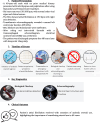Anabolic steroids as the substrate for atrial fibrillation: a case report
- PMID: 39545154
- PMCID: PMC11561561
- DOI: 10.1093/ehjcr/ytae585
Anabolic steroids as the substrate for atrial fibrillation: a case report
Abstract
Background: Atrial fibrillation (AF) is the most frequently encountered sustained arrhythmia worldwide. This supraventricular rhythm disorder is precipitated by advanced age, valvular heart disease, hypertension, heart failure, congenital heart defects, and others. However, the role of anabolic steroids (ASs) abuse in precipitating AF remains insufficiently researched and largely underreported, despite their known cardiovascular risks.
Case summary: We present the case of a 40-year-old male bodybuilder who was admitted to the emergency department with symptomatic AF. His medical history revealed the use of ASs, which was suspected to be the trigger. A thorough biological evaluation and echocardiography were performed, revealing no structural or functional cardiac abnormalities. After electrical cardioversion and discontinuation of AS use, the patient's rhythm returned to normal, with no recurrence of arrhythmia during follow-up.
Discussion: This case highlights the potential but underexplored link between AS use and the onset of AF. Although ASs are known to affect cardiovascular health by promoting hypertension, left ventricular hypertrophy, and endothelial dysfunction, their role in arrhythmogenesis, particularly in AF, remains unclear. In this patient, the absence of other identifiable triggers, combined with the resolution of symptoms upon steroid cessation, strongly suggests a causal relationship. Further research is needed to clarify the mechanisms through which ASs may contribute to the development of AF, particularly in younger, otherwise healthy individuals such as athletes and bodybuilders. This case underscores the importance of awareness among clinicians regarding the potential cardiac risks associated with AS use.
Keywords: Anabolic steroids; Arrhythmia; Atrial fibrillation; Case report.
© The Author(s) 2024. Published by Oxford University Press on behalf of the European Society of Cardiology.
Conflict of interest statement
Conflict of interest: None declared.
Figures
Similar articles
-
Pharmacological approaches in the treatment of atrial fibrillation.Curr Med Chem. 2004 Jan;11(1):13-28. doi: 10.2174/0929867043456241. Curr Med Chem. 2004. PMID: 14754423 Review.
-
Atrial fibrillation, the arrhythmia of the elderly, causes and associated conditions.Anadolu Kardiyol Derg. 2002 Mar;2(1):55-60. Anadolu Kardiyol Derg. 2002. PMID: 12101796 Review.
-
Pharmacological cardioversion of atrial fibrillation: current management and treatment options.Drugs. 2004;64(24):2741-62. doi: 10.2165/00003495-200464240-00003. Drugs. 2004. PMID: 15563247 Review.
-
Echocardiographic assessment of left atrial morphology and function to predict maintenance of sinus rhythm after electrical cardioversion in patients with non-valvular persistent atrial fibrillation and normal function or mild dysfunction of left ventricle.Cardiol J. 2020;27(3):246-253. doi: 10.5603/CJ.a2019.0068. Epub 2019 Jul 17. Cardiol J. 2020. PMID: 31313277 Free PMC article.
-
Canadian Cardiovascular Society atrial fibrillation guidelines 2010: management of recent-onset atrial fibrillation and flutter in the emergency department.Can J Cardiol. 2011 Jan-Feb;27(1):38-46. doi: 10.1016/j.cjca.2010.11.014. Can J Cardiol. 2011. PMID: 21329861
References
-
- Palatini P, Giada F, Garavelli G, Sinisi F, Mario L, Michieletto M, et al. Cardiovascular effects of anabolic steroids in weight-trained subjects. J Clin Pharmacol 1996;36:1132–1140. - PubMed
-
- Christou GA, Christou MA, Žiberna L, Christou KA. Indirect clinical markers for the detection of anabolic steroid abuse beyond the conventional doping control in athletes. Eur J Sport Sci 2019;19:1276–1286. - PubMed
Publication types
LinkOut - more resources
Full Text Sources
Research Materials
Miscellaneous



